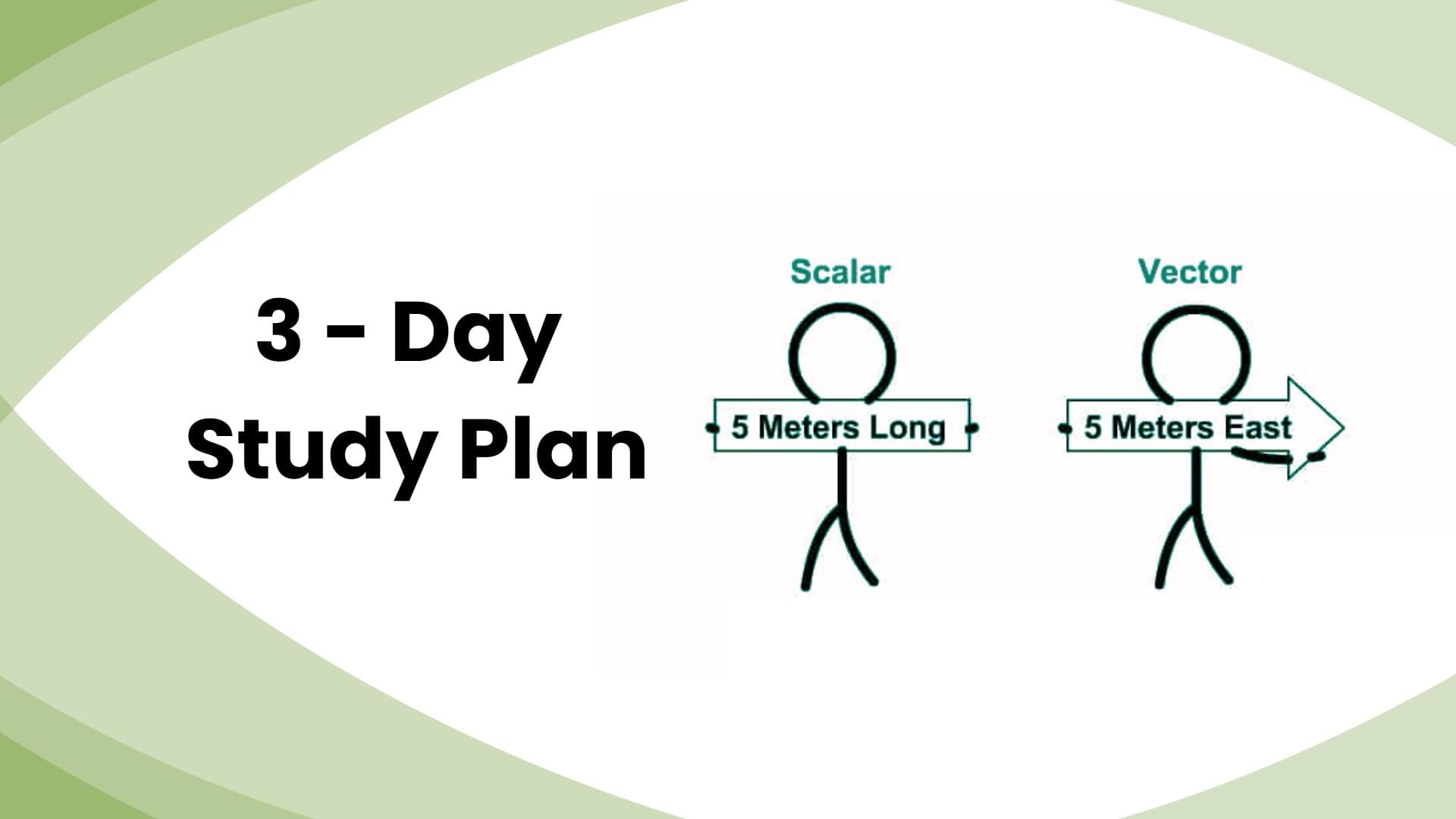JEE Exam > JEE Notes > Physics for JEE Main & Advanced > 3-Days Study Plan: Vectors
3-Days Study Plan: Vectors | Physics for JEE Main & Advanced PDF Download
Introduction
- Vectors are a key topic in Physics, helping you understand quantities with both magnitude and direction, like force or velocity.
- This is important for exams such as JEE or NEET, where you'll solve problems on addition, subtraction, and products of vectors.
- This 3-day study plan is made to help you learn quickly and effectively. You'll start with the basics, move to operations and products, and finish with practice and revision. Each day has simple steps with readings, videos, and practice from EduRev resources.
- Follow it step by step to build a strong grasp of vectors in a short time.

Study Plan
Day 1: Basics of Vectors - Definitions, Types, and Operations
Start with the fundamentals of vectors. Learn what vectors are, their types (like position, unit vectors), and how to resolve them into components. Also, cover addition and subtraction of vectors to understand how they combine.
- Read: Vectors: Definition, Types & Unit Vectors
- Read: Resolution, Addition & Subtraction of Vectors
- Watch: Vectors (YouTube)
- Watch: Addition of Vectors and Subtraction of Vectors (YouTube)
- Practice: Draw vector diagrams and solve basic addition/subtraction problems from the readings.
Day 2: Vector Products and Advanced Concepts
Focus on the products of vectors, including dot product (scalar) and cross product (vector). Understand their meanings, formulas, and uses, like finding angles or areas.
- Read: Product of Vectors
- Watch: Cross Product of 2 Vectors (YouTube)
- Watch: Vector Projections (YouTube)
- Study: PPT: Vectors
- Practice: Calculate dot and cross products for sample vectors and find projections.
Day 3: Practice, Solved Examples, and Revision
Use this day to practice problems and revise everything. Look at solved examples to see how to apply concepts, and use quick tools for review.
- Study: Solved Examples: Vectors
- Study: HC Verma Summary: Physics and Mathematics
- Review: Mind Map: Vectors
- Use: Flashcards: Vectors
- Revise: Mnemonics: Vectors and Cheat Sheet: Vectors
- Practice: Solve mixed problems on all topics and review mistakes using solved examples.
Tips for Success
- Daily Practice: Spend time each day drawing and calculating vectors to get comfortable with directions.
- Visualize Concepts: Use diagrams for addition and products to see how vectors work in space.
- Quick Reviews: Flashcards and mnemonics are perfect for memorizing formulas and types.
- Time Yourself: Practice problems with a timer to prepare for exam speed.
- Clarify Doubts: If stuck, rewatch videos or check solved examples right away.
- Stay Focused: Keep sessions short, 1-2 hours per day, to avoid tiredness.
- Revise Actively: On Day 3, quiz yourself using flashcards before the final practice.
The document 3-Days Study Plan: Vectors | Physics for JEE Main & Advanced is a part of the JEE Course Physics for JEE Main & Advanced.
All you need of JEE at this link: JEE
|
320 videos|999 docs|210 tests
|
FAQs on 3-Days Study Plan: Vectors - Physics for JEE Main & Advanced
| 1. What are vectors and why are they important in physics and mathematics? |  |
Ans. Vectors are quantities that have both magnitude and direction. They are essential in physics and mathematics because they allow for the representation of various physical phenomena, such as force, velocity, and acceleration. Understanding vectors is crucial for solving problems related to motion, equilibrium, and other concepts in mechanics.
| 2. How do you add and subtract vectors? |  |
Ans. Vectors can be added and subtracted using the head-to-tail method or by using components. In the head-to-tail method, the tail of one vector is placed at the head of the other, and the resultant vector is drawn from the tail of the first vector to the head of the last vector. When using components, each vector is broken down into its horizontal and vertical components, which are then added or subtracted algebraically.
| 3. What is the significance of the dot product and cross product of vectors? |  |
Ans. The dot product of two vectors measures the extent to which they point in the same direction and is useful for calculating the angle between them. It is given by A·B = |A| |B| cos(θ), where θ is the angle between the vectors. The cross product, on the other hand, results in a vector that is perpendicular to the plane formed by the two original vectors. It is used to determine torque and rotational effects in physics and is given by A × B = |A| |B| sin(θ) n, where n is the unit vector perpendicular to the plane.
| 4. What are unit vectors and how are they used in vector analysis? |  |
Ans. Unit vectors are vectors that have a magnitude of one and are used to indicate direction. They are often represented as i, j, and k for the x, y, and z axes, respectively, in a three-dimensional coordinate system. Unit vectors are essential for expressing other vectors in terms of their components and for simplifying calculations in vector analysis.
| 5. How can vectors be applied in real-life scenarios? |  |
Ans. Vectors have numerous real-life applications, including navigation, where they are used to determine direction and distance; physics, where they help analyze forces and motion; and engineering, where they assist in designing structures and systems. In everyday life, vectors can be seen in activities like driving, where velocity and direction are crucial for safe navigation.
Related Searches
















